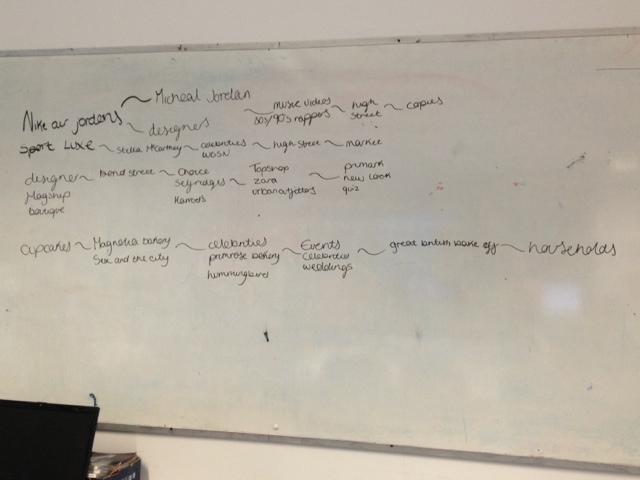This is the handout we got in the lesson, which told me some information and a definition of 'street style research' and it tells me the things I need to take. I found this sheet very helpful to me, because before this lesson I didn't even know what 'street style' actually was.
'Street Style
Many
forecasters use street style to inform their opinions of trends. The key to carrying out street style
observations comes through 3 processes:
Observations
Intuition
Interrogation
First chose
an appropriate place to carry out the street watching. Look at the streets façade (the retail
business & leisure space it contains) look at the people walking by (their style
& ethnicity) and define the streets purpose (for recreational use, retail,
leisure, business). If a street is
located in a popular “Innovator zone” then note the technology people are
using.
Always take
a notebook to record your findings, intuitions about the scene & people
& record any questions & answers when approaching public. Take a camera to capture imagery of both the
street scene and the people.
Be prepared
with a list of questions you may ask the public. Do not ask too many questions but be direct
with relevant questions.
Ask to take
their photo and advise them how you will use image – i.e in your own private
work, on a blog, pinterest etc
Look at how
to set out your findings. Is this
written up in the style of WGSN street style report, or a magazine article etc.'
In this lesson we also go a few handouts about Trends and Trend Forecasting, which made it really clear to me in what these words actually meant. There was also a handout called 'Diffusion of innovation' which I had never heard of before, I found this information very useful to me, as it really broke down the different stages of Trends, and how they come about.
'Definition of a Trend Forecaster
Trend forecasters are lifestyle
detectives: men and women who spend their time detecting patterns or shifts in
attitudes, mindsets, or lifestyle options, that run against current thinking or
how people normally behave, live, dress, communicate, and trade.
Definition of a Trend
A trend can be emotional,
intellectual, and even spiritual. A
trend can be defined as a direction which something tends to move and which has
consequential impact on the culture, society, or business sector through which
it moves.
The words “style” or “movement” are
sometimes used to describe the changes taking place over a period of time. Style is a distinctive manner, aesthetic,
method, or way of expressing something “new”, while a trend is the “direction”
in which something new or different moves.
So a style is about difference, while a trend is about difference and
the direction along which that difference travels.
'Diffusion of Innovation
The “Innovators
are the individuals who are responsible for the development of an innovation or
the introduction of a new idea. The
Innovators may not have created the original idea but they are the people who
articulate it in a way that makes sense to other members of their tribe or
group.
The” Early
Adapters” are connected to the Innovators, either close friends or colleagues and
are happy to be exposed to new ideas as they trust and respect the Innovators. The early Adapters usually have a high degree
of interconnections or involvement with other groups and are essential for
spreading the trends. Forecasters use
the term “critical mass” to describe the point at which a trend becomes
infectious few people can resist it.
This is also known as the “tipping point”, or the point at which a trend
tips over from being a minority concern to a majority one that is highly
visible and influential.
The “Early
Majority” respects the Early Adapters and therefore take on the trends. These are usually highly sociable people,
usually active on-line. Making up a
large percentage of the public they are followers but will follow opinions of those
they trust. These people will stay with
a trend for quite some time which will filter through to the “Late Majority”.
The” Late
Majority” are conservative by nature and require high levels of reassurance and
explanation about how a new idea will work and how they can benefit from it
before they buy into it. They are a
large percentage of the population.
Quite often the trend would have been adopted by this crowd in a watered
down format. This crowd are easier to
target and their tastes easier to define therefore many companies concentrate
their efforts servicing this group because it is easier to imitate than it is
to innovate
“Laggards”
are the slowest to adopt new ideas. They
are usually conservative and traditionalists, and would need a lot of
reassurance to try something new. When a
trend has been adopted by the Laggards trend forecasters refer to it as being
“flat-lined”, the end of a trend being useful to a forecaster.
After reading these two sheets as a class, we then picked a product and then discussed the different stages of the 'diffusion of innovation' we wrote on the board and took turns in coming up with something to say about the stages the products trend goes through. I took a picture of the information we gathered and uploaded it.


No comments:
Post a Comment